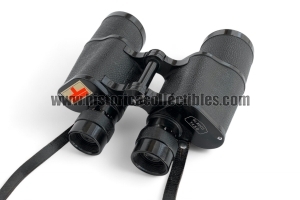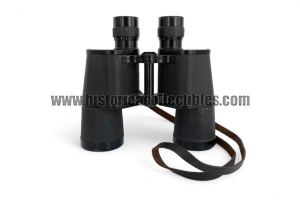Binoculars 7x50 GLAUCO Officine Galileo, Inspectorate of Aeronautical Engineering and Aeronautical Production, circa 1939
Binoculars 7x50 "GLAUCO" produced by Officine Galileo and intended for the "Inspection of Aeronautical Engineering and Aeronautical Production" or a branch of the Ministry of Aeronautics dedicated to verifying materials and supplies intended for the Royal Italian Air Force departments.
In all likelihood therefore, the scroll applied on the left plate of the binoculars indicates that it was sent by Officine Galileo to the aforementioned office, to have its characteristics verified to satisfy those requirements established during the assignment of the order.
The binoculars work in all their parts and the view is perfect.
History of Officine Galileo:
The foundation of the company dates back to 1862, by the astronomer and instrument maker Giovanni Battista Amici, a well-known scientist of the time, "skilled optician and mechanic", who had arrived in Florence in 1831 called by the Grand Duke Leopold II with the task of directing “La Specola” and the Physics Museum.
Friends to overcome the difficulties and costs of supplying scientific instruments, objects for which, given the poor industrial structure, the Grand Duchy was heavily dependent on imports, decided to start a workshop which in 1864 would take the name of "Officina Galileo". Upon Amici's death in 1863 the workshop went through a period of crisis, which was overcome thanks to Amici's successor, the Pisan scientist Giovanni Battista Donati with the help of Angelo Vegni, another scientist.
After Donati's death in 1873, production expanded to electrical and lighting instruments. At that time, forty specialized workers were employed. Initially the laboratories were housed in the buildings of the Tuscan Technical Institute, then in 1870 they were moved to a new location near the Cure barrier on the then outskirts of Florence. The excellent instruments produced were adopted by the observatories of Arcetri, Asiago and Merate.
In 1875 with the purchase of the land on which the workshop stands, A. Vegni remained the sole owner of the workshop, but with his death in 1883 the Agricultural Institute inherited the Galileo Workshop and due to the lack of interest of the Agricultural Institute, Galileo is going through a period of profound economic crisis.
In 1895 a limited partnership was established, with the general partner being the engineer Giulio Martinez and the limited partner the Vegni Institute. The new company which maintained the name Officina Galileo began its activity on 1 July 1896 and began the production of optical instruments for the Royal Navy, in particular periscopes and rangefinders, a production which would continue throughout the Second World War.
In 1899 the Vegni Agricultural Institute withdrew from the company by selling its share.
On 17 March 1907 the general meeting of shareholders resolved to dissolve the Company and on the following 4 April the Officine Galileo joint-stock company was established. One of the two vice presidents of the Board of Directors was the scientist Guglielmo Marconi. In July of the same year, a plot of land was purchased in Rifredi and in May 1909 the transfer of the machinery to the Rifredi factory began where on 27 September of the same year the regular activity of the Officine Galileo began.
Between 1909 and 1911, the first Meccano textile production pavilion was built in Rifredi called "M" and consists of a first nucleus, having a structural typology of iron and glass spans with cast iron pillars, and a subsequent expansion in reinforced concrete, made between 1914 and 1918.
The latest expansions, carried out close to the First World War, concerned the accommodation for the workers and the canteen rooms. Once the crisis due to the First World War was overcome, the period of greatest splendor for the "Galileo" was between the two wars thanks to the large orders for the Royal Navy.
During the war period, over 8,000 people were employed in the Rifredi plant and the antenna of the first radars installed on Italian ships was created by Officine Galileo, as were the fire control units and the stereoscopic rangefinders. Once the war was over, the company found itself heavily penalised, with many machinery having been transferred to Northern Italy at the end of 1943, the Allies having heavily bombed the entire Rifredi neighbourhood, with entire departments of the workshop destroyed and the Germans in retreat which had blown up a good part of the remaining machinery.
After the war, production activity was authorized by the Allies only for the production of non-strategic products. However, the problem of converting activities from military to civilian was faced and resolved thanks to the experiences acquired in a large number of sectors, so in 1945 a development plan was prepared which favored civilian production and, once again, the sectors of activity were very vast, ranging from electrical instrumentation to high vacuum equipment and in particular the production of machines and looms for the textile industry was developed also due to the presence of nearby Prato which at the end of the war had over 40% of the machinery and textile factories destroyed.
Currently, with the transfer of ownership to Finmeccanica, further major changes are taking place, as it is decided that the Company's core business must be concentrated in the military and space sectors, so other sectors, in which "Officine Galileo" was the world leader, are being sold.




